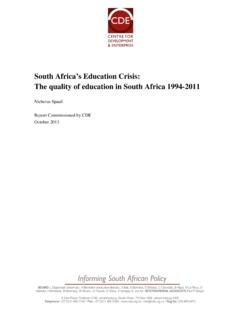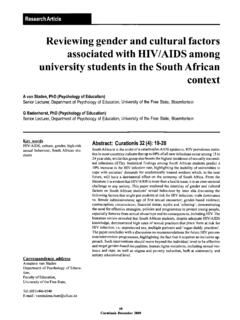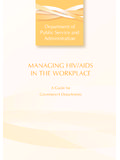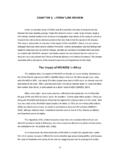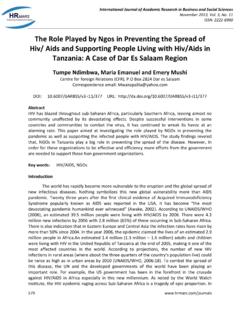Transcription of South Africa’s Treatment Action Campaign: …
1 South africa s Treatment Action Campaign: Combining Law and Social Mobilization toRealize the Right to HealthMARK HEYWOODA bstractThis article summarizes the experience and results of a campaign for access tomedicines for HIV in South africa , led by the Treatment Action campaign (TAC)between 1998 and 2008. It illustrates how the TAC mobilized people to campaignfor the right to health using a combination of human rights education, HIV treatmentliteracy, demonstration, and litigation. As a result of these campaigns, the TAC wasable to reduce the price of medicines, prevent hundreds of thousands of HIV-related deaths, but also to force significant additional resources into the healthsystem and towards the poor. The article asks whether the method of the TAC hasa wider application for human rights campaigns and, particularly, whetherthe protection of the right to health in law, and the obligation that it be progressivelyrealized by the State, provides an opportunity to advance human rights : AIDS; health; law; rightsIntroductionThe Treatment Action campaign (TAC).
2 Has shifted the debatefirmly to one of fundamental human rights and utilized the humanrights machinery established by the same government to force its handon the ARV issue (London, 2006: 12).Southern africa is the region of the world most affected by the HIV/AIDS epidemic. In South africa , a national survey in 2007 estimated that approxi-mately million people are infected with HIV. The gravity of this epidemicis linked directly to social and sexual inequality, including the disempower-ment of women, labour and refugee migration within South and SouthernAfrica, and ultimately the region s poverty. By 2008, an estimated half amillion people was receiving anti-retroviral (ARV) therapy in South africa ,but despite this the number of annual AIDS-related deaths is estimated to bebetween 300,000 and 400,000 nearly a thousand deaths a day.
3 At leasthalf of the people living with HIV who require Treatment are not receiving even with access to medication, or knowledge of how to protect oneselffrom HIV infection, under the circumstances of economic and social disad-vantage that characterize the lives of many women and young people in thenation, many people continue to be infected and to get HIV epidemic is taking its toll on South African society. Death anddisease caused by HIV has profound implications for human rights thatJournal of Human Rights Practice Vol 1 | Number 1 | March 2009 | pp. 14 36 #The Author (2009). Published by Oxford University Press. All rights recognized in the South African Constitution, including rights toequality, dignity, access to healthcare service and education. The govern-mental response to HIV has also been one of the greatest tests of SouthAfrica s democracy and law.
4 But despite the depressing down-side ofAIDS, this article aims to illustrate how South africa s growing ARV pro-gramme, estimated to be the largest in the world, and the half a millionpeople who now have access to life saving medicine, in many ways owesits existence to a campaign for the human right to health. The AIDS epi-demic catalyzed the formation of the TAC, an organization that started in1998 with a handful of people and, with the assistance of the humanrights framework, has grown in a decade into an internationally recog-nized aim is to demonstrate that there can be successful campaigns for betterhealth (and other socio-economic rights) that are driven by human rightsdemands and that take advantage of legal systems and the law. However, thearticle also analyses whether there are contextual prerequisites that willeither facilitate or frustrate the use of human rights.
5 What ingredients arerequired for the successful utilization of demands for the right to health by asocial movement?To try to answer these questions, I examine the experience of the TAC inSouth africa and attempt to draw out the approaches behind and factorsinfluencing its was launched in South africa on 10 December 1998, InternationalHuman Rights Day, by a small group of political activists. The rudimentaryconsensus within the group was that equitable access to health care, and inparticular medicines for HIV, is a human right. In addition, the leaders ofTAC appreciated that HIV, albeit a virus, is symptomatic of the deeper socialand political crisis that faces poor people, and that the growth of HIV topandemic proportions is because HIV transmission is often via social faultlines created by poverty, inequality, and social injustice (Heywood, 2000).
6 The intention of the founders of TAC was to popularize and enforce whatwas loosely described as the right of access to Treatment through a combi-nation of protest, mobilization, and legal Action . TAC s Constitutiondescribes its objectives as being to:Challenge by means of litigation, lobbying, advocacy and all forms oflegitimate social mobilization, any barrier or obstacle, including unfairdiscrimination, that limits access to Treatment for HIV/AIDS in theprivate and public so doing, TAC acquired moral and legal strength from the South AfricanConstitution, which entrenches rights to equality, life, dignity and says:15 South africa s Treatment Action CampaignEveryone has the right to have access to (a) health care services, including reproductive health care (SAConstitution, Section 27).The founders of TAC had little prior understanding of public health or itspolitics.
7 Initially, TAC regarded the primary obstacle to the realization of theright to health in the context of HIV to be privately owned pharmaceuticalcompanies, whose excessive pricing of (and profiteering from) essential ARVdrugs had placed these medicines out of reach of the poor in developingcountries (Cameron and Berger, 2005).Therefore, TAC s starting point was to insist that the excessive pricing ofessential medicines by multi-national pharmaceutical companies violated arange of the human rights that had, since 1996, been entrenched in theSouth African Constitution. It argued that intellectual property and patents,whose protection in law had been strengthened under the World TradeOrganization s 1995 TRIPS agreement, was not an inherent human right,but a device granted by the state for a public , over the coming years, TAC s experience in campaigning for theright to health demonstrated that health rights, when seriously pursued,cannot be narrowly contained or their violation blamed solely on profiteer-ing from medicines.
8 The responsibility to protect and promote human rightsin countries that have made them justiciable has implications for the conductof government in most spheres of life. The rights to dignity and equality, forexample, impact (positively or negatively) upon almost every sphere of sociallife and political governance. TAC also learned in developing countries thatgovernmental neglect of public health, even by democratic pro-poor govern-ments such as the African National Congress (ANC) in South africa , can beas much of a barrier to the right to health as profiteering by pharmaceuticalcompanies or the consequences of some aspects of economic globalization(Myburgh, 2007).The Tools of a Human Rights MovementMany civil society organizations internationally locate their activities in theinternational human rights framework, particularly, in the vision of theUniversal Declaration of Human Rights.
9 In the early 2000s, the value ofasserting human rights to demand a normative international standard seemsto have grown in currency in the field of HIV/AIDS. For example, in 1998,the United Nation s Joint Program on AIDS (UNAIDS) and the UN Officeof the High Commissioner for Human Rights (OHCHR) publishedInternational Guidelines on HIV/AIDS and Human Rights. Although docu-ments such as this have no formal legal standing, they can assist in exposingthe governments that violate these standards and can be incorporated intoadvocacy. Multi-national NGOs such as Human Rights Watch, AmnestyInternational, and Oxfam International confront different issues, but attemptMark Heywood16to do so from different points on the axis of human rights. The re-articulationof political and social issues as human rights issues by NGOs has, to someextent, contributed to what has been described as the reshaping of the stateas new technologies have created new sources of power: through the flow ofideas, information, alliances, strategies and money (Reich, 2002).
10 Many of these human rights organizations are very effective at shamingand exposing violator governments, and shaping international publicopinion. However, in their day-to-day work, they base themselves on advocacyfor ideas via an apparatus and a handful of professionals, gaining their strengthfrom their media reach and modern communications rather than workingwith a social movement where poor people becomes their own adopted a different approach. From the outset it sought to build acapacity to pursue human rights entitlements directly among the poor and tocatalyse a political movement for health. Part of the rationale for this was adistrust of the professional AIDS and human rights movement , which oftenseems part of the global industry spawned by the epidemic, articulate butineffective. In addition, unlike academics or professionals who take uphuman rights issues out of conscience, for poor people human rights are apersonal necessity.
